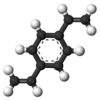Divinylbenzene
 |
|||
|
|
|||
| Names | |||
|---|---|---|---|
| Other names
Diethylene benzene, DVB, Vinylstyrene
|
|||
| Identifiers | |||
| ChemSpider | |||
| ECHA InfoCard | 100.013.932 | ||
| EC Number | 215-325-5 | ||
| Properties | |||
| C10H10 | |||
| Molar mass | 130.19 g·mol−1 | ||
| Appearance | pale, straw-colored liquid | ||
| Density | 0.914 g/mL | ||
| Melting point | −66.9 to −52 °C (−88.4 to −61.6 °F; 206.2 to 221.2 K) | ||
| Boiling point | 195 °C (383 °F; 468 K) | ||
| 0.005% (20°C) | |||
| Solubility in other solvents | Soluble in ethanol and ether | ||
| Vapor pressure | 0.7 mmHg (20°C) | ||
| Hazards | |||
| Flash point | 76 °C (169 °F; 349 K) | ||
| Explosive limits | 1.1%-6.2% | ||
| US health exposure limits (NIOSH): | |||
|
PEL (Permissible)
|
none | ||
|
REL (Recommended)
|
TWA 10 ppm (50 mg/m3) | ||
|
IDLH (Immediate danger)
|
N.D. | ||
|
Except where otherwise noted, data are given for materials in their standard state (at 25 °C [77 °F], 100 kPa).
|
|||
|
|
|||
| Infobox references | |||
Divinylbenzene (DVB) consists of a benzene ring bonded to two vinyl groups. It is related to styrene (vinylbenzene) by the addition of a second vinyl group. It is a colorless liquid is manufactured by the thermal dehydrogenation of isomeric diethylbenzenes. Under synthesis conditions, o-divinylbenzene converts to naphthalene and thus is not a component of the usual mixtures of DVB.
It is produced by dehydrogenation of diethylbenzene:
Divinylbenzene is usually encountered as a 2:1 mixture of m- and p-divinylbenzene, containing also the corresponding isomers of ethylvinylbenzene.
Styrene and divinylbenzene react to form the copolymer styrene-divinylbenzene, S-DVB or Sty-DVB. The resulting cross-linked polymer is mainly used for the production of ion exchange resin.
These compounds are systematically called diethenylbenzene, although this nomenclature is rarely encountered.
...
Wikipedia


